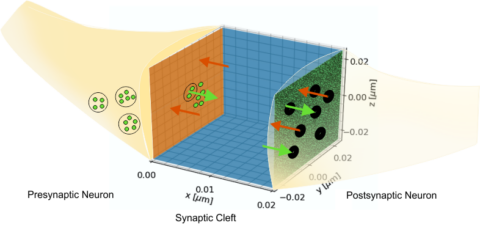The Role of Molecule Spillover in Multi-Synapse Molecular Communication
Recently, the design of communication networks for nanodevices, so-called nanonetworks, has gained a lot of attention. Nanonetworks could enable exciting new applications in biomedicine, environmental monitoring, and manufacturing. Molecular communication (MC), i.e., the exchange of information via molecules, is a bio-hybrid approach to nanonetwork design.
Synaptic signaling is a natural implementation of the MC paradigm which has evolved over thousands of years to cope with challenges similar to the ones that are faced in the design of synthetic MC systems, e.g. energy harvesting and the mitigation of inter-symbol interference (ISI). In synaptic MC information is transmitted from the presynaptic neuron (transmitter) to the postsynaptic neuron (receiver) by the diffusion of neurotransmitters in the synaptic cleft (channel). In addition, neurotransmitters can be transported back into the presynaptic neuron either directly or via uptake at surrounding glial cells. In this way neurotransmitters are not only recycled for future reuse, but they are also prevented from escaping the synapse and diffusing to neighboring synapses where they would potentially present an unintended signal (co-channel interference).
The relevance of molecule uptake for the mitigation of co-channel interference between neighboring synapses has been investigated in the literature by means of experimental and simulation studies. A comprehensive theoretical model which relates the synaptic configuration in terms of geometry and chemical properties in a multi-synaptic setting to the severeness of co-channel interference, however, is not available up to now.
In this thesis, a multi-synapse model shall be developed based on recent progress in the single-synaptic modeling of spillover. The predictions of this model shall be compared to previous results from experimental and simulation studies whenever this is possible. For the validation of the model beyond the availability of previous results, particle-based stochastic computer simulations shall be implemented. Finally, the newly developed model shall be used to investigate the impact of various biophysical parameters on the mitigation of co-channel interference.
Guidelines for the thesis:
- Literature review of synaptic molecular communication
- Literature review of synaptic spillover
- Adaptation of the analytical single-synapse model from the literature
- Implementation of a single-synapse particle-based simulator
- Validation of the particle-based simulator with the analytical resul
- Formulation of the multi-synapse model in terms of a boundary value problem
- Implementation of the analytical solution to this boundary value problem based on the analytical single-synapse result
- Extension of the particle-based simulator to multiple synapses and verification with the analytical solutionComparison of the obtained results with experimental and simulation studies found in the literature
- Investigation of the inter-synaptic co-channel interference subject to different synaptic configurations
Prerequisites:
- Familiarity with basic linear time-invariant systems theory (as acquired e.g. in the course “Signals and Systems”)
- Programming skills in any feasible programming language / programming environment, e.g. MatLab, Python, C
Contact:
